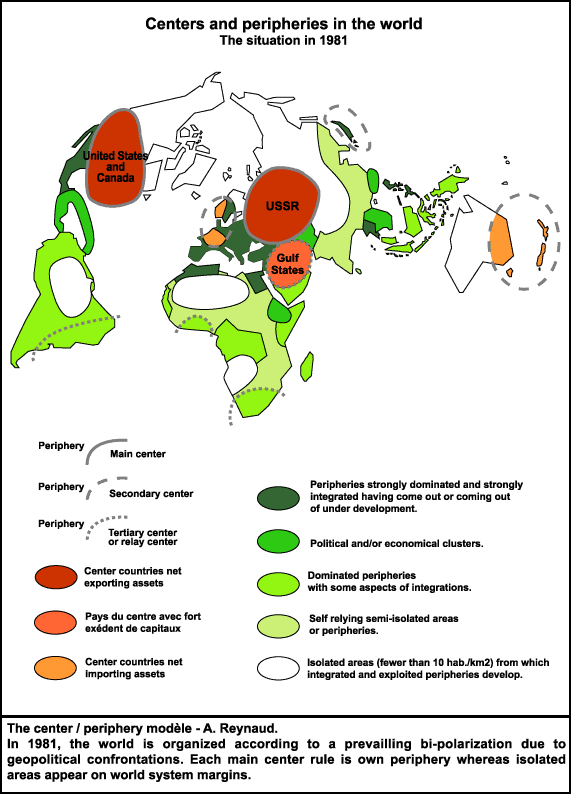Centre
From Geography
The centre is a term in the field of geography to describe the core area of a region. This can be seen on multiple scale levels. For example, seen on a city, the city center usually is the centre of the town, leaving te suburbs to be periphery. In countriess, parts of the world, or even the entire world, such distinctions can be made. Çentres can be the most important economically cities, which are located the most centrally. According to Knox and Marston (2007, p.405) central places are the settlements in which certain types of products and services are available to consumers.
The centre is the opposite of the periphery. The periphery is usually the lesser developed area of a region.
Example of centre-periphery relation [1]
Contents |
Centrality
Thus, there is a centre and a periphery. But how can we decide about the border between this two areas? What makes places 'centre' or 'central' and why do some activities concentrate in certain places and not in other areas? When centrality is playing a role, we can use the concept of centrality made by Walter Christaller (1966)[2]. He became famous with his Central Place Theory about centrality, which states that a central place is a geographic location where services and goods are provided for a surrounding area.
Scale Levels
Just like when describing periphery, we can look at (the) centre at different scale levels.
City-Level We can look at this definition on a city perspective. An example is that the neighborhoods at the centre of cities are usually more beautiful and developed than the city edges. The less developed areas are called periphery and the city centres are called centre. Central areas usually are characterized by wealth, less criminality (than in periphical areas), and a cleaned environment.
International Level We can also look at this term at a bigger scale level. Countries for example also have a centre and a periphery. In the Netherlands 'de Randstad' can be seen as the (economic) centre of the country while for example the provinces of Drenthe, Zeeland and Limburg can be seen as the periphery because of the lower (economic) activity. The centre/periphery distinction could also be used at a world scale. In this case "The West" is the centre and (parts of) Africa, Latin America and Asia are periphery. How can we decide about the border between centre and periphery? What makes places periphery and why aren't activities concentrated in periphery areas, but are they concentrated in centres? The concept of centrality is giving an answer at this question in the Central Place Theory which states that a central place is a geographic location where services and goods are provided for a surrounding area. This way of thinking means that the periphery is dependent on the centre. The dependent area is also referred to as "catchment area".
Conclusion
When speaking about centre or periphery, it is always a comparison between two or more areas. You can't define a periphery when you don't know anything about a centre/central area.
References
- Christaller, W. (1933). Die zentralen Orte in Süddeutschland. Translated by Baskin, C. (1966) as Central Places in Southern Germany. Prentice Hall.
- Knox, P.L. & Marston, S.A. (2007). Human Geography. Places and regions in a global context. 4th edtion, Pearson.
Contributors
- Page created by Robert Wursten - October 10th 2012
- Page enhanced by Marleen Revenberg - October 17th 2012
- Page edited by Michiel van Rijn--MichielVanRijn 23:50, 25 October 2012 (CEST)
- Page edited by Kasper van de Langenberg - December 30th 2012
